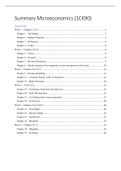Summary Microeconomics (1CK90)
Contents
Week 1 – Chapters 1,2,3,4 ................................................................................................................. 2
Chapter 1 – The Market ................................................................................................................. 2
Chapter 2 – Budget Constraint ....................................................................................................... 3
Chapter 3 – Preferences ................................................................................................................. 4
Chapter 4 – Utility ......................................................................................................................... 6
Week 2 – Chapters 5,6,7,8 ................................................................................................................. 6
Chapter 5 – Choice ........................................................................................................................ 6
Chapter 6 – Demand ...................................................................................................................... 8
Chapter 7 – Revealed Preference ................................................................................................... 9
Chapter 8 – Slutsky Equation (Very important; at least one question at the exam) ........................ 10
Week 3 – Chapters 8,9,14,15 ........................................................................................................... 11
Chapter 9 – Buying and Selling ................................................................................................... 11
Chapter 14 – Consumer Surplus (slide 14 important) ................................................................... 12
Chapter 15 – Market Demand ...................................................................................................... 14
Week 4 – 19,20,21,22 ...................................................................................................................... 15
Chapter 19 – Technology (from here firm behavior) .................................................................... 15
Chapter 20 – Profit Maximization ................................................................................................ 16
Chapter 21 – Cost Minimization (more important) ....................................................................... 17
Chapter 22 – Cost Curves ............................................................................................................ 18
Week 5 – Chapters 23,24,16,25 ....................................................................................................... 20
Chapter 23 – Firm Supply ............................................................................................................ 20
Chapter 24 – Industry Supply....................................................................................................... 21
Chapter 16 – Equilibrium............................................................................................................. 22
Chapter 25 – Monopoly ............................................................................................................... 23
Week 6 – Chapters 28, 32 ................................................................................................................ 24
Chapter 28 – Oligopoly................................................................................................................ 24
Chapter 32 – Exchange ................................................................................................................ 26
,Week 1 – Chapters 1,2,3,4
Chapter 1 – The Market
Model: a simplified representation of reality. Art in choosing the right simplifications: - no need to add
every detail – understand simple cases and then add complexity.
Exogenous variable: determined by factors NOT in the model
Endogenous variable: determined by factors in the model
The first simplification that we’ll make in our model is that all apartments are identical in every respect
except for location. • Two sorts of apartments: inner ring and outer ring • The price of the outer ring
apartments is fixed: it is an exogenous decision variable.
The optimization principle: People try to choose the best patterns of consumption that they can afford.
Reasonable assumption “rational”
The equilibrium principle: Prices adjust until the amount that people demand of something is equal
to the amount that is supplied. Want to know what the price is.
THE DEMAND CURVE
Reservation price: maximum willingness to pay (P ≤ R)
• If the price is lower than your reservation price à BUY
• If the price is higher than your reservation price à DON’T BUY
• If the price is just equal to your reservation price à BUY
Drawing the demand curve
• Ask every potential renter for their reservation price: how much they are
willing to pay for rent of an inner-ring apartment
• Represents the number of renters who would accept a given price (X-axis) as
a function of a price (Y-axis)
With many people the demand curve is Smooth and Decreasing à
THE SUPPLY CURVE
Drawing the supply curve
• Represents the number of apartments available (X-axis) as a function of
the price (Y-axis)
Depends on the time frame
• We look at the short run—when supply of apartments is fixed.
Competitive market: Many independent landlords renting out apartments
for the highest price the market will bear • Same price for all apartments
MARKET EQUILIBRIUM
Put the demand curve and the supply curve on the same graph. The
equilibrium price p* is where the quantity of apartments demanded equals
the quantity supplied.
• What happens if the price is greater than p*?
Vrijgekomen apartments
• Lower than p*?
Higher demand than supply, incentive to increase the price
COMPARATIVE STATICS
What happens to the equilibrium price if:
Case 1: The supply of apartments is increased?
➔ The price decreases
, Case 2: Some of the apartments are sold as condos to people who previously rented?
➔ If the demand and supply both shift left by the same amount the price is
unchanged
Case 3: The landlords must pay a tax on apartments of $50 per year?
➔ No change at all
WAYS TO ALLOCATE APARTMENTS
1. Competitive market à Many small landlords (PE = YES)
2. Discriminating monopolist à One landlord owns all the apartments and knows all the renters’
reservation prices (e.g., auction) The amount the people pay is different, but who gets the apartments is
the same. (PE = YES). So - a discriminating monopoly is possible when different sets of consumers
have different price elasticities of demand and/or when consumers cannot switch to buy a substitute.
3. Ordinary monopolist à One landlord owns all the apartments and does not know all the renters’
reservation prices. Revenue Box = price x quantity (PE = NO, subletting apartments)
4. Rent control à A fixed rental price is decided (e.g., by the government). Suppose that the city decides
to impose a maximum rent that can be charged for apartments, say pmax. We suppose that the price pmax
is less than the equilibrium price in the competitive market, p∗. If this is so we would have a situation
of excess demand: there are more people who are willing to rent apartments at pmax than there are
apartments available. Model fails to answer the question here (PE = NO)
Which is the best?
An allocation is Pareto efficient (PE) if there is no way to make some group of people better off without
making someone else worse off. If something is Pareto inefficient: It is possible to make people better
off without making someone else worse off = there exists a Pareto improvement
Chapter 2 – Budget Constraint
CONSUMPTION BUNDLES (x1, x2)
Consider two goods. • (𝑥1, 𝑥2): amount of each good is consumed
• (𝑝1, 𝑝2): prices of the two goods • 𝑚: money the consumer has to spend or income.
Budget constraint/ Budget set: p1x1 + p2x2 ≤ m
All (𝑥1, 𝑥2) that satisfy this constraint make up the budget set of the consumer (a.k.a. : We call this set
of affordable consumption bundles at prices (p1,p2) and income (m)
BUDGET LINE
Budget line: 𝑝1𝑥1 + 𝑝2𝑥2 = 𝑚. • All (𝑥1, 𝑥2) that satisfy this constraint cost exactly m. • Can also be
written as 𝑥2 = 𝑚/𝑝2 – (𝑝1/𝑝2) 𝑥1. What is the slope of the budget line? à -p1/p2. Slope of budget line
measures opportunity cost of good 1, how much of good 2 you must give up in order to consume more
of good 1. What is the vertical intercept? à m/p2. What is the horizontal intercept? à m/p1
TWO GOODS IS USUALLY ENOUGH
Theory works with more than two goods, but cannot draw pictures. Often think of good 2 as a composite
good, representing money to spend on all other goods. Budget constraint then becomes 𝑝1𝑥1 + 𝑥2 ≤ 𝑚
• Money spent on good 1 (𝑝1𝑥1) plus the money spent on good 2 (1 ∗ 𝑥2) has to be less than or equal
to the amount available (𝑚). • Setting a price to one is called the numeraire price
HOW THE BUDGET LINE CHANGES
Increasing income: an increase in income causes a Increasing price: if good 1 become more
parallel shift outward of the budget line. expensive, the budget line becomes steeper





